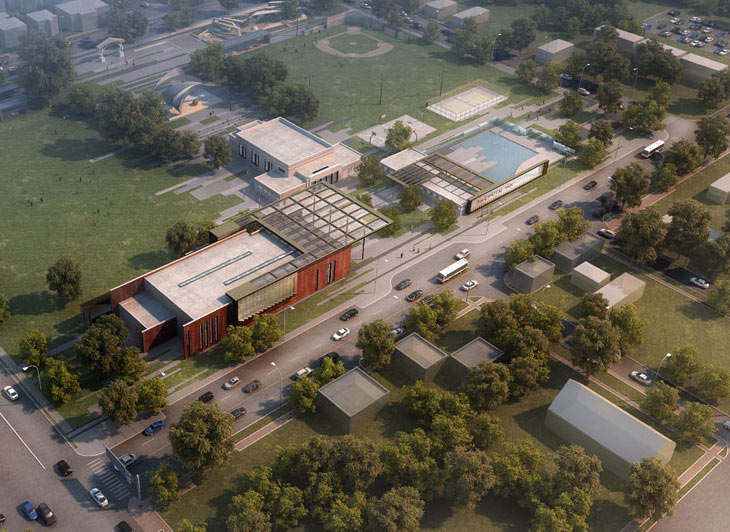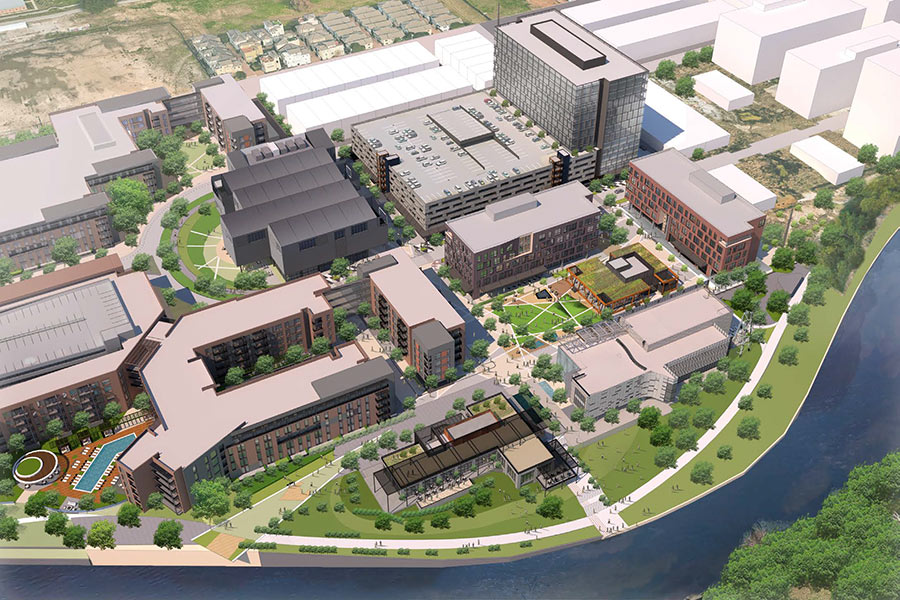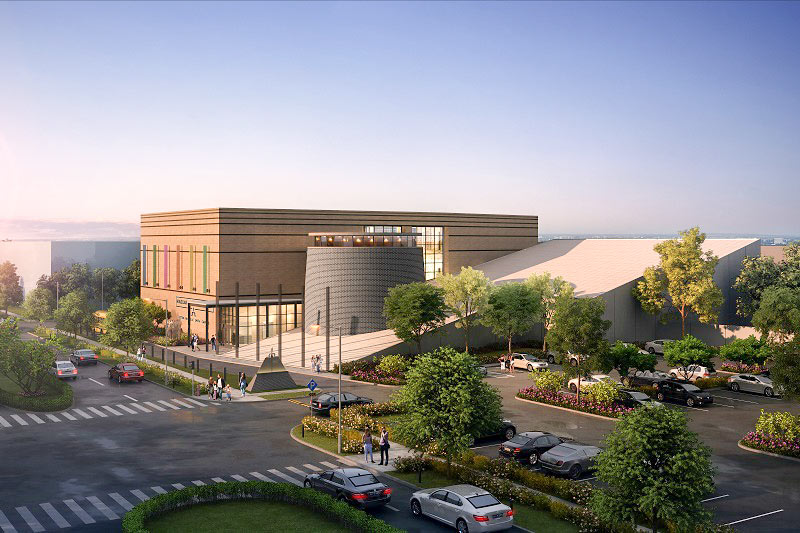
Update, 7/20: The renderings and description have been removed from both LAI’s website and the online portfolio website where they were previously displayed. At the request of the architect, Swamplot has removed the images as well; this article has been updated.
A glassy sphere shown in a rendering currently previously displayed on the website of Colorado-based LAI Design Group looked to be part of a design for a nonprofit workspace and affordable housing thinktank called the Coleman Global Center. An attached description of the project doesn’t didn’t specifically identify the location of the rendering (beyond noting that project is “in Houston”). But another rendered view of the project (posted to porfolio site Behance) showed the bubble right across Dowling St. from the almost-finished new community center at Emancipation Park (and its easy-to-identify reflection pool) at the corner with Elgin. And Leah Binkovitz’s May interview with state representative Garnet Coleman and a set of collaborating Third Ward nonprofit directors ambiguously highlights that particular corner as playing an important role in plans to shift how gentrification unfolds in the neighborhood.
Compare the rendering below (which shows the bubble building in place) to architect Phil Frelon’s angled aerial rendering of Emancipation Park (included further below):
***
Despite not being in Midtown, the lot was bought by the Midtown Redevelopment Authority in mid-December — Binkovitz reports that the agency owns about 3.5 million sq.ft. of land in Third Ward, as part of an attempt coordinated by Coleman to reserve land in the area for affordable housing development. The agency’s purchase extends along Elgin from Dowling to a discontinuous stretch of St. Charles St., visible in the upper left below; across Elgin (to the right), the drawings showed what appear to be significant changes to the southeast corner of Elgin and Dowling (which currently holds Navy Seafood).
- Third Ward Looks to Shift the Gentrification Conversation [Urban Edge]
- Coleman Global Center for Innovative Housing Excellence [LAI Design Group]
- Historic Emancipation Park [Phil Frelon]
- Previously on Swamplot: What Emancipation Park Might End Up Looking Like;Â Freeing Up Funds for Emancipation Park
Images: LAI Design Group (Coleman Global Center), Phil Frelon (Emancipation Park)





Well, it looks like a Tank.
I should like to go it there and think about affordable housing.
And strategize about peoples needs and how to meet them…
Reminds me of Biff’s place in Back to the future dos. Are you sure Biff Tanner isn’t the one building that? This seems so shady….
Yes, I’d agree that the optics of levering one well-defined local entity to expropriate wealth from that neighborhood to an adjoining one, but then using that wealth to buy up land and do nothing with it until after blowing through some incredible sum of money on a palatial office building on the site of a neighborhood institution (Navy Seafood) within which to *contemplate* preserving some sense of the old community…its just stupendously bad.
.
I don’t know if there’s any criminal wrongdoing here or whether the administrative law just isn’t written well-enough to disallow these practices, but where there’s smoke there’s often fire. Hopefully somebody will start paying attention.
An affordable housing group should rent Class B office space wherever they can get it cheapest to reserve more money for helping people to be housed affordably. Certainly not buying up land “to preserve it for affordable housing” and then building some ridiculous, inefficient office building on it.
Not sure the 3rd ward is really known for it’s prime location class B office space. It’s a global think-tank center with visitors and policymakers to be attending from around the world. I don’t think shelling out money for some nice purpose-built offices is anything out of line for this category of non-profits. Don’t know anything about the place and where they got their money though.
Garnett Coleman? Coleman Global Center? I’m confused. CGC has no web site to explain it’s provenance and raison d’être.
I’m suspicious about their intent in buying up large tracts of Third Ward property for “affordable housing.” We all know how that story will likely end: with displaced residents and housing that’s far from affordable.
Non-Profit as in spend a ton of money on an office building to house 6 figure jobs. When your expenses are high non-profit is a polite way of saying “support us and our group” while doing much less for the cause. Reminds me of a mega church.
LOL …. what a waste of cyberspace!
It is nothing but a dream of a egocentric politician
Suspicion, confusion, and speculation can be abated by reading the “May interview”. Just need to click…
There is much more to this Midtown Redevelopment Authority story. I’ve been slowly trying to piece it together for a couple of years now. I would love help researching. If anybody would like to meet to dig deeper into this, please let me know.
@ detroux: I read that article and it actually raises additional red flags in light of the recent SCOTUS ruling regarding affordable housing in Texas. The objective should hardly be that affordable housing is built in neighborhoods where housing is already affordable and deteriorating and getting auctioned off for lack of interest; what Coleman is doing is a kind of neo-segregationism. In what universe is that good public policy!?
The money to buy this land is being siphoned from the Midtown TIRZ, which was established to promote and help improve the area between 59 on the east, 59 on the south, Bagby on the west and the Pierce elevated on the north. None of the properties that they have bought are in the midtown jurisdiction but have been scooped up with their funds and orchestrated by State Representative Garnet Coleman. They have been holding these properties for quite a while now and I believe roughly 12 low cost homes have been built which doesn’t seem right or Kosher.
The MRA recently voted to sell an ENTIRE city block (2002 Live Oak) to HOU Homes for $1.50 psf, totaling $93,750. AND they’ll reimburse development costs AND reimburse $11,000 – $30,000 per townhouse sold. They’re estimating to build 31 townhouses on the block. This is the same type of developments they say they don’t want. Somebody’s pockets are getting fat due to this arrangement.
http://houstonmidtown.com/wp-content/uploads/2016/05/MRA-Minutes-03.31.16.pdf
Considering the small difference in distance between midtown and 3rd ward it makes perfect sense to me to instead use the midtown TIRZ affordable housing funds in the 3rd ward to greatly multiply the amount of land that can be purchased and reserved.
.
Idealistically this should not be the primary intent (maximizing value of available funds) as the idea is to maintain a mix of high and low incomes within the same neighborhoods. If you’re just creating brand new entire “affordable housing neighborhoods” then the schools and infrastructure will suffer and create new pockets of extreme poverty. However, knowing the state of NIMBYs in this city the pathway to development in midtown would be much more prolonged, expensive and painful than in that of the 3rd ward.
.
Beyond that, the funds were always reserved for affordable housing units and could never be used for anything else. This is only neo-segregationism if you consider every master planned community built in Houston as neo-segregationism.
@TheNiche What is being done is probably seen as a necessity in a public policy universe that enabled the Project Row House, which has been incredibly successful. It has created interest among the general population to preserve the third ward feel, and has done so by the only way something like PRH can: through a patronage system. But if you want to get of the row, so to speak, and beyond the arts, a more stable source of income is needed and precluding proven economic development, banks are out –I think this is where the Coleman approach comes into play. Yeah, I think the SCOTUS decision may be a show-stopper.
When I think of places that have “preserved their identity”, I mostly think of failed states, extremely repressive or corrupt governments, or places that continue to recover from a legacy thereof. There are fewer and fewer in the world, but places like Somalia, Myanmar, North Korea, Saudi Arabia, or Cambodia come to mind. Traditional values and ways of life are undergoing a dynamic transformation anywhere that they’re allowed to, and this is a kind of dynamism that results in real economic development. Billions of people have taken it upon themselves to make their lives better. That figure includes some people that formerly lived in the 3rd Ward — but unlike in a wholly repressive regime, most of them have moved from there if and when they’ve become able.
.
That process can be thought of as a kind of demographic distillation, separating-out different types of people from the same subculture according to ambition and wealth — or the lack thereof. This is critical because 3rd Ward was bustling once, but it doesn’t bustle and won’t bustle as such without any of the better-off middle-class black families moving back there and opening and patronizing businesses. What has been lost is *totally lost* and self-perpetuating. The only thing that exists that can possibly be preserved is a highly concentrated and bleak form of urban poverty. What’s there is nothing to celebrate.
With the sale of that entire block for that price which is normally what a lot of 5,000 goes for in that area how can that not be considered MASSIVE FRAUD?
I wish real investigative journalism still existed. This would be a perfect project. Instead we have either ones that only dig till they find enough tidbits to support their agenda or just investigate enough to play the gotcha game.
I’m a buyer at $1.75/sq ft ! ! ! ! And I promise to build some even cheaper housing.
It should be noted that the Midtown and Uptown TIRZs are required by law (as petition-created zones) to dedicate one-third of their TIRZ revenue to affordable housing, which is not required to be provided within the zone. In the case of both TIRZs, this means in terms of land acquisition, property can be acquired in places where land prices allow a great deal more acreage to be acquired.
.
What is different between the two zones is that Midtown has retained some level of control over where and how these affordable housing funds are spent, while Uptown has simply relinquished control to the City’s Housing and Community Development Department.
ew2003 Please contact us at http://www.leelandpark.com for help in your quest!
I’m with Spoonman. Affordable housing advocates should be in class B office space as close as they can get to the affordable housing that they advocate for. Radical, creative designs should be for the housing; not for the group’s own headquarters building. (It is desperately needed; there really hasn’t been much meaningful advancement in affordable housing design since the early 1990s – and I’m of the few that sleek, forward looking design that works well with its surroundings, and offers them something, can do a lot to counter anti-housing NIMBYs)
Actually I would say the housing groups should have offices IN the housing they advocate for. Either that or key personnel should live in the housing. (Just in one or two units per complex).
.
Housing advocates and officials always talk about the need to push low income housing into high opportunity neighborhoods. But as wealthy, well connected whites (most of them are, at least here in Texas), they themselves should be living and working in that affordable housing. They can use their connections to make sure that problems concerning maintenance or crime are promptly addressed. They can serve as role models for the residents. They can help oversee social activities to make the affordable housing into viable communities.
I’m late to the game, but I attended several meetings held by Midtown’s cultural arts committee nearly two years ago. A major topic of discussion was affordable housing for artists within a city that was pricing out artists as real estate prices increased, but still expected art to exist. If that plan had backing and the ability to be executed, then this land purchased by Midtown may be a living sign of it. I don’t remember who was on that committee, but definitely representatives from Ensemble Theatre and Center for Contemporary Craft.